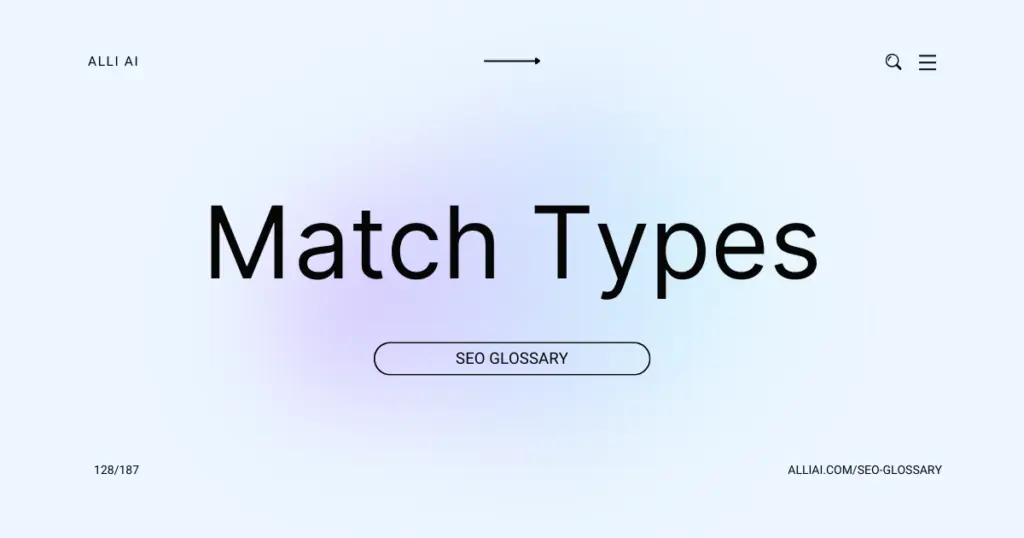What Does Match Types Mean?
In the context of search engine marketing, “Match Types” refer to the different ways you can set up your keywords to control how closely the search terms need to match with your keywords for your ads to appear to users. Here are the main types: 1. Broad Match: This is the default match type that reaches the widest audience. Ads may show on searches that include misspellings, synonyms, related searches, and other relevant variations. 2. Phrase Match: Ads will appear for searches that match a phrase, or close variations of that phrase, with additional words before or after. However, the words need to appear in the same order as your keyword. 3. Exact Match: This type requires that the search query be exactly the same as your keyword, although it can include close variations, but not words before or after the keyword. Each match type offers different benefits and levels of control, helping you optimize your search engine marketing efforts based on your specific goals.
Where Does Match Types Fit Into The Broader SEO Landscape?
Match Types are primarily associated with search advertising in PPC (pay-per-click) campaigns rather than SEO (Search Engine Optimization). In the context of search engine advertising, such as Google Ads, Match Types determine how closely a user’s search query needs to match a keyword that an advertiser is bidding on. The different Match Types (broad match, phrase match, and exact match) help in refining which search queries will trigger the display of ads.
However, the concept of Match Types can indirectly inform SEO strategies. By analyzing performance data from PPC campaigns, including which Match Types are most effective at driving traffic and conversions, SEO professionals can gain insights into keyword relevance and user search intent. This information can help in optimizing website content, meta tags, and keyword strategies to improve organic search visibility and rankings. Thus, while Match Types are not a direct component of SEO, understanding and analyzing them can provide valuable insights that enhance SEO efforts.
Real Life Analogies or Metaphors to Explain Match Types
1. Broad Match: Imagine a fishing net cast wide into the ocean, catching all sorts of fish, not just the ones you wanted. This is similar to how broad match works: it captures a wide array of search queries, some closely related to your keywords and others more loosely associated.
2. Phrase Match: Think of a train on a train track, where your keyword phrase is the train and the additional words are extra carriages attached either at the beginning or the end. Phrase match keeps the core words in sequence while allowing some flexibility on either side.
3. Exact Match: Picture a lock and key mechanism where the keyword is the key, and the search query is the lock. The key (exact match keyword) must fit perfectly into the lock (the searcher’s exact term) to unlock (trigger your ad).
How the Match Types Functions or is Implemented?
1. Broad Match: This is the default setting for all keywords. With Broad Match, an ad may show on searches that include misspellings, synonyms, related searches, and other relevant variations. Google’s algorithm determines the relevance of the keyword to user queries, which can lead to a wide range of ad placements. There’s no need for special symbols when setting it.
2. Broad Match Modifier: This match type allows more control than broad match by requiring specific keywords to be present in the search query for the ad to be considered. It’s designated by placing a plus symbol (+) directly in front of one or more words in a keyword phrase. All words preceded by a + must appear in the user’s search exactly or as a close variation.
3. Phrase Match: Ads will show on searches that match a phrase, or are close variations of that phrase, with additional words before or after. It’s specified by putting quotation marks (” “) around the keyword phrase. This controls ad placements more tightly than broad match, ensuring the phrase order remains unchanged in the query.
4. Exact Match: This match type allows ads to show on searches that match the exact term or are very close variations of that exact term. It’s designated with square brackets ([ ]). The close variations here may include singular or plural forms, misspellings, or other variants that don’t change the intent behind the query.
5. Negative Match: Used to prevent ads from showing on searches containing a specific word or phrase. It’s designated by placing a minus sign (-) before the keyword. This helps filter out traffic that is not relevant to the business, thus saving on wasted ad spend and improving campaign focus. Negative keywords can be set at the ad group or campaign level.
Impact Match Types has on SEO
Match Types are a concept specific to pay-per-click (PPC) advertising, such as Google Ads, rather than a direct factor in search engine optimization (SEO) for organic search rankings. Match Types help determine how closely a user’s search query needs to match a keyword in PPC campaigns. The precision of match types (broad, phrase, exact) in PPC affects how targeted or wide-reaching an ad campaign is, which can influence the traffic volume and type that a website attracts through paid search ads.
However, indirect effects on SEO can occur as increased relevant traffic from effectively targeted PPC can lead to improved user engagement metrics. If users from PPC ads have positive interactions with the website, such as longer dwell times and lower bounce rates, these metrics could indirectly positively influence organic rankings. Furthermore, higher traffic volume can lead to increased brand awareness, potentially elevating organic search click-through rates over time.
SEO Best Practices For Match Types
1. Identify Keywords: Start by identifying the keywords relevant to your website or business. Use keyword research tools like Google Keyword Planner, SEMrush, or Ahrefs to find keywords that are relevant and have good search volume.
2. Select Match Types: For each keyword, decide which match types to use:
– Broad Match: Use broad match sparingly to capture traffic from a wide range of search queries, including synonyms, misspellings, and related searches.
– Phrase Match: Use phrase match to target queries that contain your keyword in the exact order but may include additional words before or after.
– Exact Match: Use exact match for highly targeted traffic, where the search query must match your keyword exactly.
3. Create Campaign Structure: Organize your keywords into different ad groups within your Google Ads campaigns. Use a logical structure based on product, service, or another categorization system, grouping similar keywords together. For instance, separate ad groups for each match type can help in better budget allocation and bid strategies.
4. Set Up Ads: Write compelling ad copy for each ad group. Ensure that the ads are relevant to the keywords grouped in that ad group. The relevance between the keywords and the ad copy improves quality score, which can positively impact ad positions and cost-per-click.
5. Adjust Bids by Match Type: Typically, bid highest for exact match keywords as they are more likely to convert, followed by phrase match, and lowest for broad match. Adjust bids according to the performance and the value each keyword and match type brings.
6. Use Negative Keywords: Implement negative keywords to filter out unwanted traffic and prevent your ads from showing on irrelevant searches. Regularly review search terms and add irrelevant terms as negative keywords.
7. Monitor Performance: Regularly monitor the performance of your keywords and match types. Use metrics such as click-through rate (CTR), conversion rate, and cost per acquisition (CPA) to evaluate performance.
8. Optimize Continuously: Refine your match types and keyword lists based on the performance data. Scale bids for high-performing keywords and reduce bids or pause low-performing ones. Regularly test new keywords and match types to explore potential opportunities.
9. Leverage Modified Broad Match (if applicable): Although modified broad match is no longer a standalone option as of recent changes, you can achieve similar effects by strategically using phrase match with careful negative keyword implementation to control the breadth of your keyword targeting.
10. Use Smart Bidding Strategies: Consider using Google’s automated bidding strategies like Target CPA or Enhanced CPC, which can automatically adjust bids based on the likelihood of conversion, factoring in the different nuances of each match type.
Common Mistakes To Avoid
1. Using Broad Match Exclusively: Leads to irrelevant traffic and increased costs. Optimize by using more specific match types like phrase or exact match to improve relevance and control.
2. Neglecting Negative Keywords: Without negative keywords, you might attract irrelevant queries. Regularly update negative keywords lists to filter out unwanted traffic.
3. Overusing Exact Match: Limits traffic and potentially misses out on relevant queries. Balance with broader matches and utilize modified broad match options.
4. Inadequate Keyword Grouping: Poorly organized keyword groups can lead to irrelevant ad presentations. Segment keywords into closely related groups to enhance ad relevance and performance.
5. Ignoring Match Type Performance: Not reviewing performance data per match type can lead to inefficient campaigns. Regularly analyze and adjust bids and match types based on performance metrics.
6. Failing to Adjust Bids by Match Type: Different match types may warrant different bid strategies. Adjust bids based on the match type’s cost, traffic quality, and conversion rates.
7. Mismatching Keyword and Match Type: Using complex phrases in broad match or single words in exact match might not yield optimal results. Match keyword complexity and length with appropriate match types.






